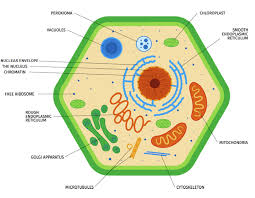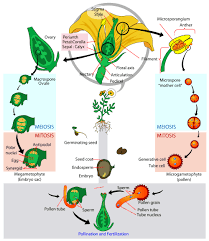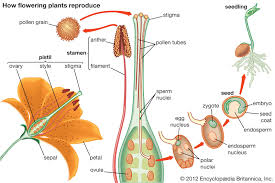Cells vary widely in structure and function, but they have some important properties in common, and all cells represent the basic unit of living materials. Great variation occurs among the cells of different organisms and among cells in different areas of the same organism.
Cell division is the process through which cells reproduce themselves and multicellular organisms grow (mitosis). When cells divide, each resultant part is a complete, although at first a smaller cell (daughter cell).
Following division, the newly formed daughter cells grow rapidly to get to the size of the original cell. Cell division is really a process of duplication or multiplication.
Gametogenesis is a process in which gametes are formed, which includes meiosis by which the chromosome number is changed from the diploid or 2n number to the haploid or n number. The process also includes the development of eggs and sperm.
Fertilization is the union of male and female gametes to restore the chromosome number to 2n or diploid.
Read Also: Peach Rose Flowers (Persian Yellow): All You Need To Know About
Basic Structure and Functions of the Plant Cell in Agriculture

This is the smallest unit of life. All living organisms are composed of these basic articles, which range from simple unicellular structures of bacteria and protozoa to complex structures of plants and animals. The generalized plant cell is composed of a cell wall, cytoplasm, and nucleus.
1. Nucleus
2. Cell wall
3. Cytoplasm
However, the parts of the cell are far more complex than indicated. A typical animal cell is like the plant cell except for the absence of a cell wall.
Understanding Cell Division in Plant Growth and Development
The most fundamental part of cell division is the replication of Deoxyribonucleic Acid (DNA), which must occur before any changes related to the early stages of mitosis can be observed.
Two interrelated processes are involved in cell division:
(1) Mitosis the nuclear division
(2) Cytokinesis the changes in the cytoplasm.
The process (mitosis) of cell division is continuous from the time a cell first shows evidence of beginning to divide until the two daughter cells are completely formed.
Mitosis, therefore, is the mechanism by which new cells are formed and by which these cells retain identical chromosome numbers and hereditary factors before and after every cell division.
Each cell still has the full chromosome number. For instance, if a man has 46 chromosomes, after each mitotic division, each cell will still have 46 chromosomes.
Read Also: Significance and Uses of Monkey Orchid Flowers
Gametogenesis and Fertilization in Crop Reproduction

Sexual reproduction in plants involves the production of gametes through a process called gametogenesis, and the union of these gametes is known as fertilization.
Gametogenesis only occurs in specialized cells of the reproductive organs (anthers and ovary). Gametes contain half the number of chromosomes, usually referred to as haploid and denoted with the letter “n”.
During gametogenesis, the number of chromosomes is reduced by half. This reduction division is known as meiosis.
In higher plants, meiosis takes place in the flower just before seed formation. Thus, meiosis occurs in the anthers to produce pollen grains and in the ovary to produce eggs.
Let us have examples of how gametogenesis works:
1. Man has 46 chromosomes denoted as 2n or diploid (44 autosomal and 2 sex chromosomes). During gametogenesis, the chromosome number will be reduced to half, which is 23 chromosomes, known as haploid and denoted by “n”.
2. Maize has 20 chromosomes, denoted as 2n or diploid. During gametogenesis, the chromosome number will be reduced to 10 chromosomes. This is known as haploid and denoted as n.
3. Diploid is the complete chromosome number of a species denoted as 2n. Haploid is half of the diploid number and is denoted as n. This reduction division is called meiosis. Meiosis, therefore, is the process by which chromosome numbers are halved in the formation of sex cells or gametes.
Gametogenesis: Formation of Sex Cells in Plants
| Male Gamete | Female Gamete | |
|---|---|---|
| Pollen (n) | Haploid | Ovary (n) Haploid |
Haploid – Having a single set (genome) of chromosomes in a cell, the reduced number (n).
Fertilization Process in Flowering Plants
1. Fertilization: This is the union of male and female gametes to restore the chromosome number characteristic of the species. In higher plants, the anthers split to release pollen grains, which come in contact with the stigma either naturally or artificially.
The pollen grain wall splits, and a pollen tube penetrates the receptive stigma and grows down the style. The pollen grains and egg cell nuclei, both of which have half the chromosome number and gene complements, unite to produce the embryo mother cell with the chromosome number characteristic of the species.
Zygote – (2n) Diploid
Differences Between Mitosis and Meiosis in Plant Reproduction
| Mitosis | Meiosis |
|---|---|
| Two daughter cells are produced per cycle. | Four cellular products (gametes) are produced per cycle. |
| Genetic content of mitotic products is identical. | Genetic content of meiotic products is different. |
| Chromosome number of daughter cells is the same as that of the mother cell. | Chromosome number of meiotic products is half that of the mother cell. |
| Mitotic products are usually capable of undergoing additional mitotic division. | Meiotic products cannot undergo another meiotic division, although they may undergo mitotic division. |
| Normally occurs in most or all somatic cells. | Occurs only in specialized cells like pollen grains and ovary. |
| Associated with asexual reproduction. | Associated with sexual reproduction. |
Do you have any questions, suggestions, or contributions? If so, please feel free to use the comment box below to share your thoughts. We also encourage you to kindly share this information with others who might benefit from it. Since we can’t reach everyone at once, we truly appreciate your help in spreading the word. Thank you so much for your support and for sharing!

